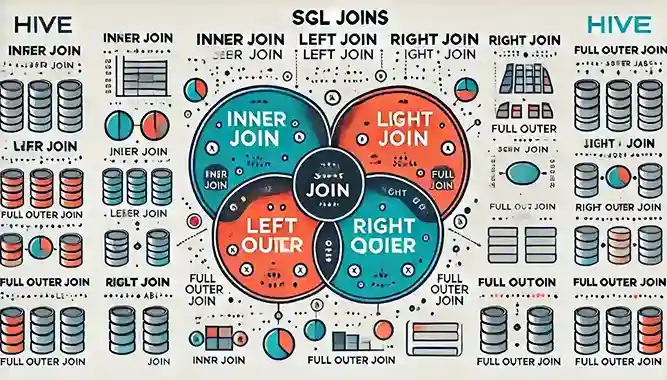Understanding SQL Joins in Hive - INNER JOIN, LEFT JOIN, RIGHT JOIN, and FULL OUTER JOIN
Diagram showing the types of SQL joins in Hive: INNER JOIN, LEFT JOIN, RIGHT JOIN, and FULL OUTER JOIN
Understanding SQL Joins in Hive: A Comprehensive Guide with Examples for Efficient Data Combining
Understanding SQL Joins with Examples
Introduction
SQL JOIN is a powerful clause used to combine data from multiple tables based on a related column between them. Joins help retrieve meaningful insights by merging records efficiently. This article explains different types of SQL joins with practical examples using developer and company tables.

Why Use Joins?
- To combine data from multiple tables.
- To fetch only relevant data efficiently.
- To eliminate redundancy in database design.
SQL JOIN Syntax
JOIN table_reference
ON join_condition
| table_reference {LEFT | RIGHT | FULL} [OUTER] JOIN table_reference
ON join_condition
| table_reference LEFT SEMI JOIN table_reference ON join_condition
| table_reference CROSS JOIN table_reference;
Example Data
Let's assume we have two tables: developer and company.
Developer Table (developer)
| name | codingSkill | experience |
|---|---|---|
| Alice | Python | 5 years |
| Bob | Java | 3 years |
| Carol | SQL | 7 years |
| Dave | JavaScript | 4 years |
Company Table (company)
| company_id | name | company_name |
|---|---|---|
| 1 | Alice | |
| 2 | Bob | Microsoft |
| 3 | Dave | Amazon |
Types of Joins in SQL
1. INNER JOIN (Default JOIN)
Retrieves matching records from both tables.
SELECT d.name, d.codingSkill, d.experience, c.company_name
FROM developer d
JOIN company c ON d.name = c.name;
Result:
| name | codingSkill | experience | company_name |
|---|---|---|---|
| Alice | Python | 5 years | |
| Bob | Java | 3 years | Microsoft |
| Dave | JavaScript | 4 years | Amazon |
2. LEFT OUTER JOIN
Retrieves all records from the left table (developer), along with matching records from the right table (company). If no match is found, NULL is returned.
SELECT d.name, d.codingSkill, d.experience, c.company_name
FROM developer d
LEFT JOIN company c ON d.name = c.name;
Result:
| name | codingSkill | experience | company_name |
|---|---|---|---|
| Alice | Python | 5 years | |
| Bob | Java | 3 years | Microsoft |
| Carol | SQL | 7 years | NULL |
| Dave | JavaScript | 4 years | Amazon |
3. RIGHT OUTER JOIN
Retrieves all records from the right table (company), along with matching records from the left table (developer). If no match is found, NULL is returned.
SELECT d.name, d.codingSkill, d.experience, c.company_name
FROM developer d
RIGHT JOIN company c ON d.name = c.name;
Result:
| name | codingSkill | experience | company_name |
|---|---|---|---|
| Alice | Python | 5 years | |
| Bob | Java | 3 years | Microsoft |
| Dave | JavaScript | 4 years | Amazon |
4. FULL OUTER JOIN
Retrieves all records from both tables. If no match is found, NULL is returned.
SELECT d.name, d.codingSkill, d.experience, c.company_name
FROM developer d
FULL OUTER JOIN company c ON d.name = c.name;
Result:
| name | codingSkill | experience | company_name |
|---|---|---|---|
| Alice | Python | 5 years | |
| Bob | Java | 3 years | Microsoft |
| Carol | SQL | 7 years | NULL |
| Dave | JavaScript | 4 years | Amazon |
Choosing the Right JOIN Type
| JOIN Type | Description |
|---|---|
| INNER JOIN | Returns only matching records in both tables. |
| LEFT JOIN | Returns all records from the left table and matched records from the right table. |
| RIGHT JOIN | Returns all records from the right table and matched records from the left table. |
| FULL JOIN | Returns all records from both tables. |
Conclusion
Using SQL joins allows you to retrieve meaningful data from multiple tables efficiently. Depending on the requirement, you can use INNER JOIN for exact matches, LEFT JOIN for keeping all left-side records, RIGHT JOIN for keeping all right-side records, or FULL OUTER JOIN for combining everything.
Mastering SQL joins will help you handle complex queries and manage relational databases effectively.
Stay Tuned for More!
For more SQL tutorials and database optimization techniques, visit 'www.developerindian.com'
Table of content
- Introduction to Apache Hive
- Hive Architecture and Components
- Hive Modes
- Installation and Setup
- Working with Hive Tables
- HiveQL Basics
- Advanced Hive Concepts
- Partition Pruning
- Dynamic Partitioning
- Query Optimization in Hive
- Working with Hive Indexes
- ACID Transactions in Hive
- File Formats in Hive
- Text File
- ORC (Optimized Row Columnar)
- Parquet
- Avro
- Sequence File
- Hive Functions
- Built-in Functions (String, Date, Math)
- Aggregate Functions
- User-Defined Functions (UDFs)
- Integrating Hive with Other Tools
- Hive and Apache Spark
- Hive and Pig
- Hive and HBase
- Hive Interview Questions
- Best Practices in Hive
- Performance Optimization
- Handling Large Datasets
- Security and Access Control
- FAQs and Common Errors in Hive
- Troubleshooting Hive Issues
- Frequently Asked Questions
- Resources and References
- Official Hive Documentation
- Recommended Books and Tutorials